Practicing various yoga styles can significantly enhance holistic wellness and physical fitness. Explore how Hatha builds strength, Vinyasa promotes cardiovascular health, Yin encourages relaxation, and Restorative aids recovery. Understand the cultural influences shaping these practices and discover how environmental factors affect style preferences. Consistent engagement with diverse yoga forms can lead to improved mental clarity and overall life satisfaction.
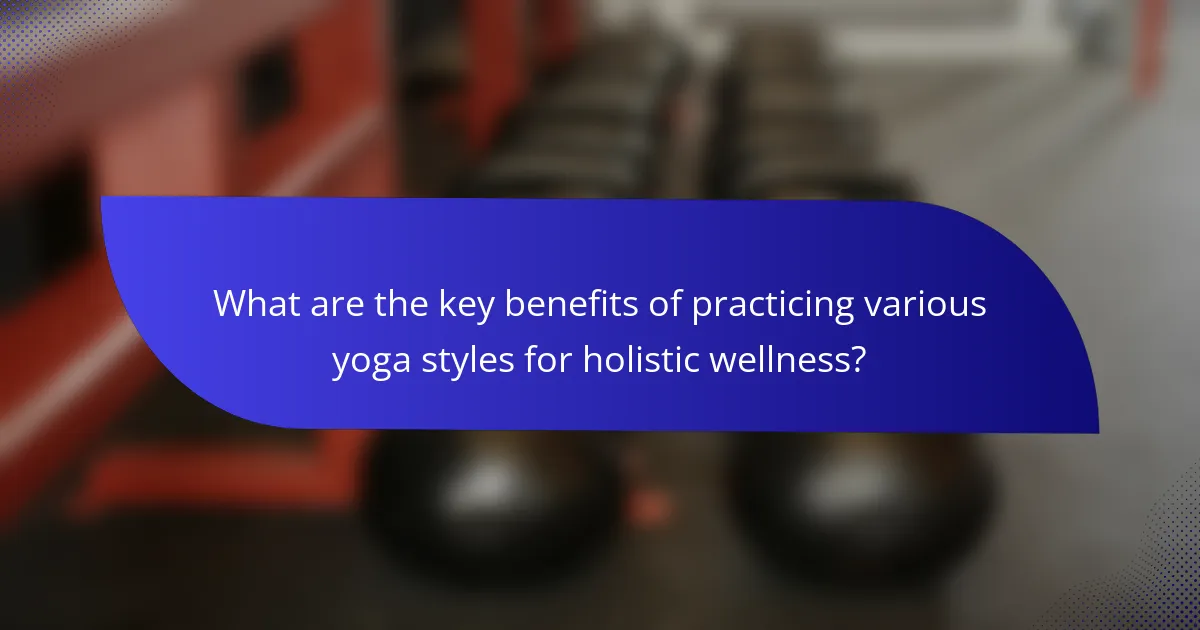
What are the key benefits of practicing various yoga styles for holistic wellness?
Practicing various yoga styles offers key benefits for holistic wellness and physical fitness, including improved flexibility, strength, mental clarity, and stress reduction. Each style targets different aspects of health.
Hatha yoga enhances physical strength and balance, while Vinyasa promotes cardiovascular health through dynamic movement. Restorative yoga focuses on relaxation and stress relief, which aids mental wellness. Ashtanga builds endurance and discipline, fostering a strong mind-body connection.
Research indicates that consistent yoga practice can lower cortisol levels, improve mood, and increase overall life satisfaction. Engaging in diverse yoga styles allows individuals to tailor their practice to their specific wellness goals, enhancing both physical and mental health outcomes.
How do different yoga styles contribute to physical fitness?
Different yoga styles enhance physical fitness through varied approaches. Hatha yoga builds strength and flexibility with its slower pace, while Vinyasa offers dynamic sequences that improve cardiovascular health. Ashtanga emphasizes strength and stamina through a structured series of postures. Iyengar focuses on alignment and precision, enhancing balance and posture. Bikram, practiced in heated rooms, boosts endurance and detoxification. Each style contributes uniquely to overall wellness, catering to diverse fitness goals.
Which yoga styles are most effective for mental health improvement?
Hatha, Vinyasa, and Yin yoga are effective styles for improving mental health. Hatha promotes relaxation and mindfulness, Vinyasa enhances mood through dynamic movement, and Yin encourages deep introspection. Each style offers unique benefits that support mental well-being.
What role does breath control play in enhancing yoga practice?
Breath control significantly enhances yoga practice by promoting focus and relaxation. It regulates energy flow, improves concentration, and deepens the connection between mind and body. Proper breath control also aids in achieving postures more effectively, enhancing overall physical fitness. Additionally, it can reduce stress and increase mindfulness, contributing to holistic wellness.
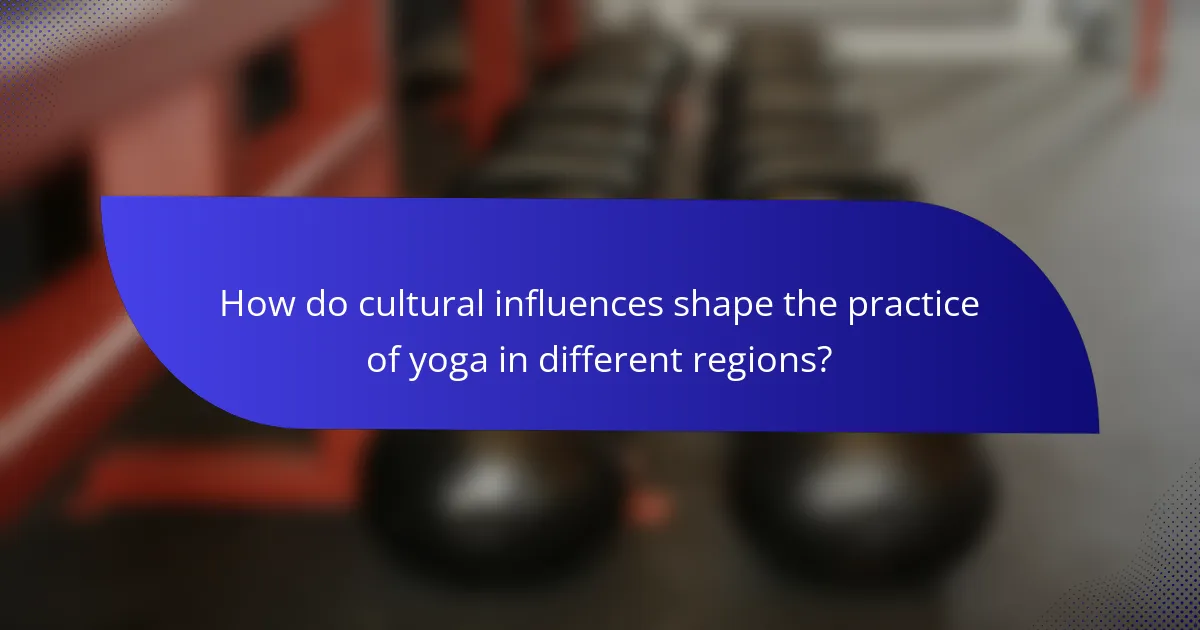
How do cultural influences shape the practice of yoga in different regions?
Cultural influences significantly shape yoga practices, resulting in diverse styles across regions. For instance, Indian traditions emphasize spirituality and meditation, while Western adaptations often focus on physical fitness and stress relief.
In Asia, yoga incorporates local philosophies and practices. In Japan, for example, yoga blends with Zen principles, promoting mindfulness. In contrast, in the United States, power yoga emphasizes vigorous physical activity.
Regional climates and lifestyles also affect yoga styles. Hot yoga in warmer regions enhances flexibility and detoxification. In colder areas, restorative yoga focuses on warmth and relaxation.
These variations illustrate how cultural contexts influence the expression of yoga, creating a rich tapestry of practices that cater to different needs and preferences.
What are the popular yoga styles in North America and their unique attributes?
Hatha, Vinyasa, and Ashtanga are popular yoga styles in North America, each with unique attributes. Hatha focuses on basic postures and alignment, making it ideal for beginners. Vinyasa emphasizes fluid movement and breath synchronization, promoting cardiovascular fitness. Ashtanga features a rigorous sequence of poses, enhancing strength and flexibility. These styles cater to diverse wellness needs, from relaxation to intense physical conditioning.
How does the approach to yoga differ in Europe compared to North America?
The approach to yoga in Europe tends to emphasize traditional practices, while North America focuses on fitness and modern adaptations. European styles often incorporate historical philosophies and cultural contexts, such as Hatha and Iyengar yoga, which prioritize alignment and breathing techniques. In contrast, North American practices like Vinyasa and Power yoga frequently blend physical fitness with spiritual elements, appealing to a broader audience.
Additionally, European yoga studios may emphasize community and mindfulness, whereas North American studios often market high-energy classes aimed at physical results. This difference reflects unique cultural attitudes towards wellness and fitness, shaping how yoga is practiced and perceived in each region.
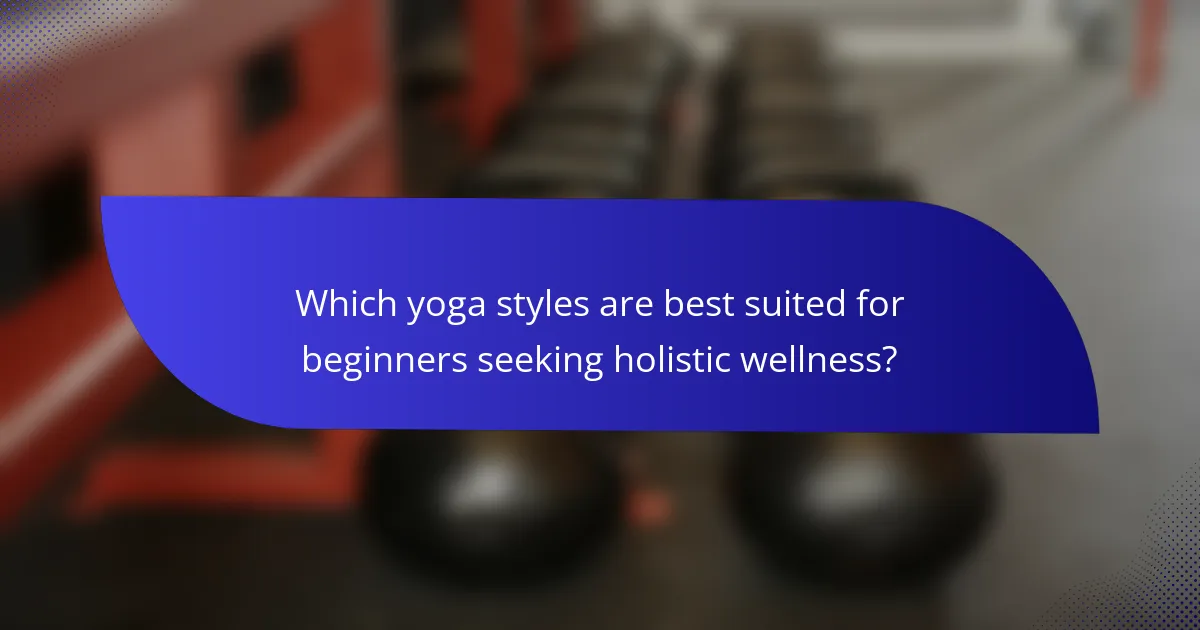
Which yoga styles are best suited for beginners seeking holistic wellness?
Hatha, Yin, and Restorative yoga are ideal for beginners seeking holistic wellness. Hatha yoga emphasizes foundational postures, promoting physical fitness and balance. Yin yoga focuses on deep stretching, enhancing flexibility and mental calmness. Restorative yoga uses props for relaxation, encouraging stress relief and mindfulness. Each style supports overall well-being through gentle practice, making them accessible for newcomers.
What factors should beginners consider when choosing a yoga style?
Beginners should consider their fitness goals, flexibility levels, and personal preferences when choosing a yoga style. Different styles offer unique benefits, such as relaxation, strength building, or increased flexibility. For example, Hatha yoga emphasizes foundational postures, while Vinyasa provides a more dynamic flow. Additionally, some styles like Yin yoga focus on deep stretching and relaxation, which may appeal to those seeking stress relief. Understanding these attributes helps beginners select a yoga practice that aligns with their wellness journey.
How can beginners safely progress in their yoga practice?
Beginners can safely progress in their yoga practice by focusing on gradual development and proper alignment. Start with foundational poses to build strength and flexibility.
1. Establish a routine: Practice consistently, aiming for at least two to three sessions per week.
2. Listen to your body: Respect your limits and avoid pushing into pain.
3. Use props: Incorporate blocks, straps, or bolsters to support your practice.
4. Focus on breath: Maintain awareness of your breath to enhance mindfulness and relaxation.
5. Seek guidance: Consider attending classes with experienced instructors for personalized feedback.
This approach fosters a safe and effective journey in yoga, enhancing overall wellness and physical fitness.

What advanced yoga styles can enhance physical fitness for experienced practitioners?
Advanced yoga styles that enhance physical fitness for experienced practitioners include Ashtanga, Power Yoga, Vinyasa, and Bikram. These styles emphasize strength, flexibility, and endurance through dynamic sequences and controlled breathing.
Ashtanga yoga is a rigorous practice that follows a set sequence of postures, promoting strength and stamina. Power Yoga incorporates strength training elements, enhancing muscle tone. Vinyasa focuses on fluid movement between poses, improving cardiovascular fitness. Bikram involves a series of postures practiced in a heated room, increasing flexibility and detoxification.
Practicing these advanced styles can lead to improved physical fitness, increased energy levels, and greater mental clarity. Each style uniquely contributes to overall wellness by challenging the body and mind.
Which unique techniques differentiate advanced yoga styles?
Advanced yoga styles utilize unique techniques that enhance physical fitness and holistic wellness. These techniques include dynamic movements, breath control, and meditative practices that differentiate them from traditional styles.
One unique technique is Vinyasa, which emphasizes fluid transitions between poses, promoting cardiovascular fitness. Another is Kundalini, focusing on energy awakening through specific breathing and chanting methods. Ashtanga involves a set sequence of postures, enhancing strength and flexibility through rigorous practice. Iyengar incorporates props for precise alignment, catering to individual needs.
These advanced techniques not only improve physical capabilities but also deepen the mind-body connection, fostering overall well-being.
How do advanced practitioners integrate strength and flexibility in their practice?
Advanced practitioners integrate strength and flexibility through balanced yoga styles that emphasize both elements. They often combine practices like Vinyasa and Hatha, which promote strength through dynamic movements while enhancing flexibility with deep stretches.
These practitioners focus on mindful transitions, ensuring that each pose builds strength and improves flexibility simultaneously. For instance, incorporating poses like Warrior II strengthens the legs while promoting hip flexibility.
Additionally, advanced practitioners may utilize props such as blocks and straps to deepen stretches and enhance strength training. This approach allows for a more personalized practice that addresses individual needs.
Ultimately, the synergy of strength and flexibility in advanced yoga practice leads to enhanced physical fitness and holistic wellness.
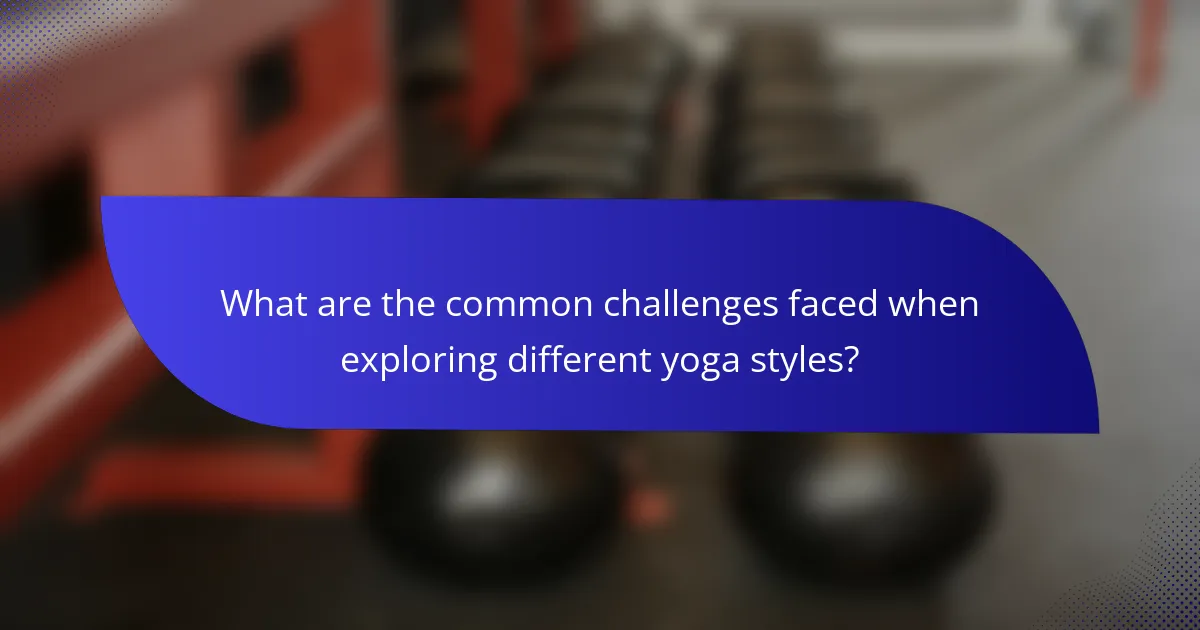
What are the common challenges faced when exploring different yoga styles?
Exploring different yoga styles often presents challenges such as finding the right fit, understanding the unique benefits of each style, and overcoming physical limitations. Practitioners may struggle with the diversity of approaches, which can lead to confusion. Additionally, the varying intensity levels and philosophies can make it difficult to choose a style that aligns with personal wellness goals. Time commitment and accessibility to classes or resources can also pose significant barriers.
How can practitioners overcome physical limitations in their yoga journey?
Practitioners can overcome physical limitations in their yoga journey by choosing adaptive yoga styles and incorporating modifications. Accessible styles like Hatha and Yin yoga focus on gentle movements and deep stretching, making them suitable for various abilities.
Using props such as blocks, straps, and bolsters enhances stability and support during poses. Practicing mindfulness and breath control fosters a deeper connection to the body, allowing practitioners to listen to their limits and progress at their own pace.
Regularly attending classes with experienced instructors provides personalized guidance and adjustments, ensuring safety and effectiveness. Establishing a supportive community can also motivate individuals to stay committed to their practice.
What strategies can help maintain motivation across different yoga styles?
To maintain motivation across different yoga styles, set clear goals and track progress. Engage with a community for support and inspiration. Explore various styles to keep practice dynamic and enjoyable. Incorporate mindfulness techniques to enhance focus and connection to the practice.
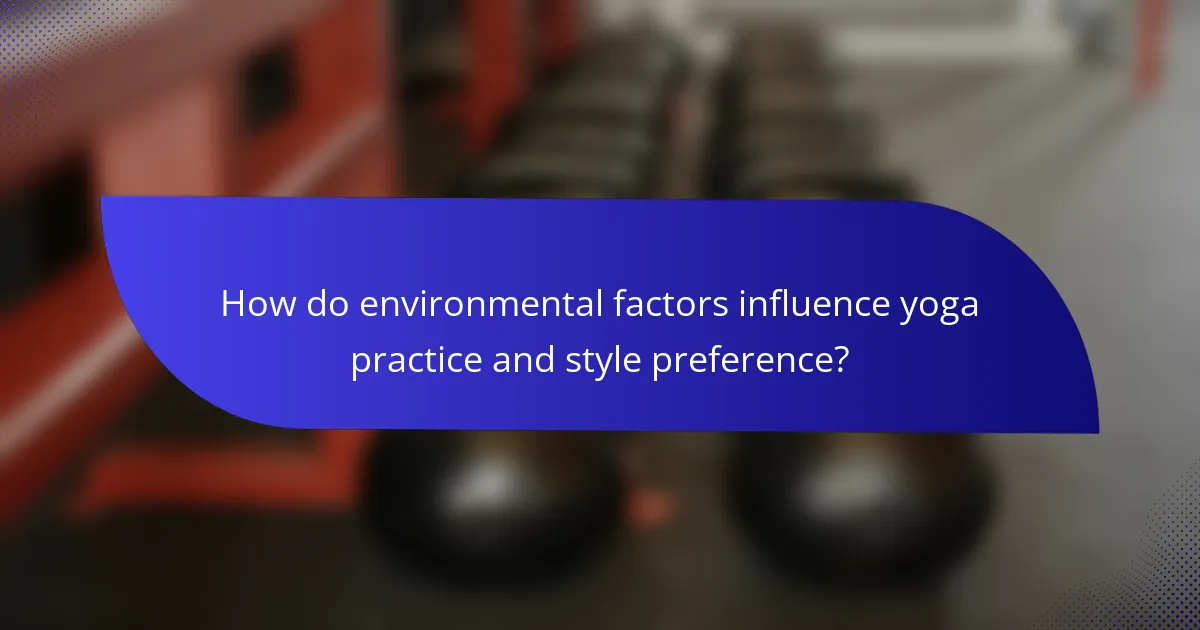
How do environmental factors influence yoga practice and style preference?
Environmental factors significantly shape yoga practice and style preference. Factors such as climate, location, and cultural background influence how individuals engage with yoga. For instance, warmer climates may encourage practices like Vinyasa or Ashtanga, which involve more movement and sweating. In contrast, cooler environments might lead practitioners to prefer restorative styles that focus on relaxation and gentle stretching.
Cultural influences also play a role; regions with rich yoga traditions may emphasize specific styles that align with local philosophies. Additionally, urban settings may promote faster-paced styles due to lifestyle demands, while rural areas might offer more tranquil environments conducive to slower practices.
Ultimately, the interplay of these environmental factors creates a diverse landscape of yoga styles, allowing individuals to choose practices that best suit their surroundings and personal preferences.
What are the effects of outdoor vs. indoor yoga sessions on wellness?
Outdoor yoga sessions enhance wellness by offering fresh air and natural surroundings, while indoor sessions provide a controlled environment. Studies show that outdoor yoga can reduce stress levels by 30%, improve mood significantly, and increase vitamin D exposure. Conversely, indoor yoga often allows for a quieter space, which can enhance focus and meditation practices. Each setting has unique benefits that cater to different wellness needs, making both valuable for holistic fitness.
How does climate affect the choice of yoga style?
Climate significantly influences the choice of yoga style, as different environments can enhance or hinder practice. In hot climates, styles like Bikram or Hot Yoga thrive, focusing on heat and flexibility. Cooler regions may benefit from restorative practices like Yin or Hatha Yoga, promoting warmth and relaxation. Humidity can affect breath control, making Pranayama techniques essential. Seasonal changes also impact energy levels, guiding practitioners to adapt their styles accordingly. Thus, understanding climate conditions helps tailor yoga practices for optimal wellness.
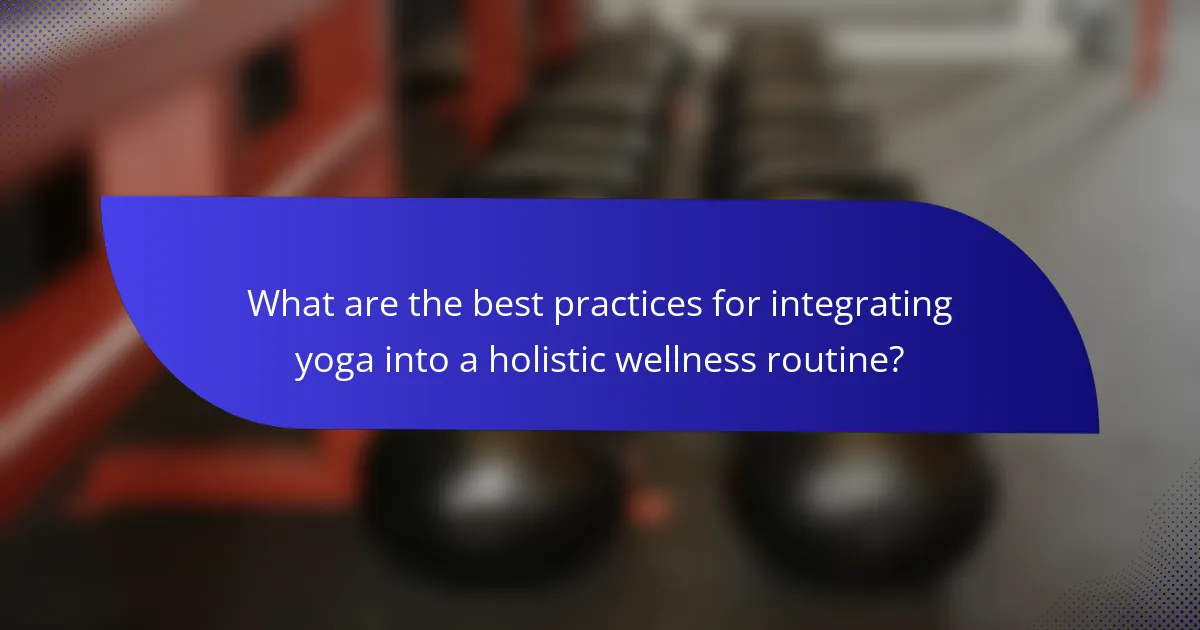
What are the best practices for integrating yoga into a holistic wellness routine?
Integrating yoga into a holistic wellness routine enhances physical fitness and mental clarity. Focus on a variety of yoga styles to address different wellness aspects.
Hatha yoga promotes physical strength and flexibility. Vinyasa offers dynamic movement, improving cardiovascular health. Yin yoga encourages deep relaxation and stress relief. Restorative yoga aids recovery and rejuvenation. Incorporating these styles creates a balanced approach to overall wellness.
Consistency is crucial; aim for regular practice to experience lasting benefits. Set specific goals to guide your routine, whether improving flexibility or reducing stress.
Consider the environment as well. A calm, dedicated space enhances focus and enjoyment during practice. Integrating mindfulness through meditation complements yoga, fostering a comprehensive wellness experience.
What common mistakes should practitioners avoid when combining yoga with fitness?
Practitioners should avoid neglecting proper alignment, overexerting during transitions, and ignoring individual limitations. These mistakes can lead to injury and hinder the benefits of yoga combined with fitness. Maintaining awareness of breath and form is essential for effective practice. Additionally, not integrating mindfulness can diminish the holistic benefits that yoga offers.
How can individuals effectively track their progress in yoga practice?
Individuals can effectively track their progress in yoga practice through consistent self-assessment and goal-setting. Regularly documenting personal experiences, such as flexibility improvements or meditation depth, enhances awareness of growth. Utilizing apps or journals to log sessions can provide insights into areas needing focus. Setting specific, measurable goals, like mastering a pose, encourages motivation and accountability. Engaging in periodic evaluations, such as monthly reflections, can help adjust practices to align with evolving wellness objectives.
What expert tips can enhance the overall yoga experience for wellness?
To enhance the overall yoga experience for wellness, focus on mindfulness, proper alignment, and breath control. Practicing mindfulness helps deepen your connection to the present moment, improving mental clarity. Correct alignment prevents injuries and maximizes the benefits of each pose. Additionally, conscious breath control, or pranayama, promotes relaxation and enhances energy flow. Incorporating these elements fosters a holistic approach to physical fitness and mental well-being in yoga practice.